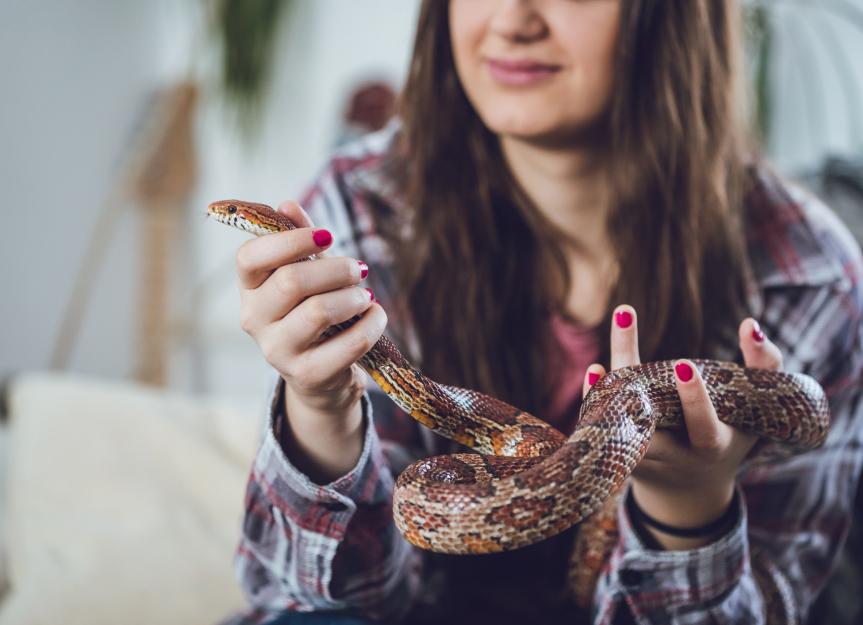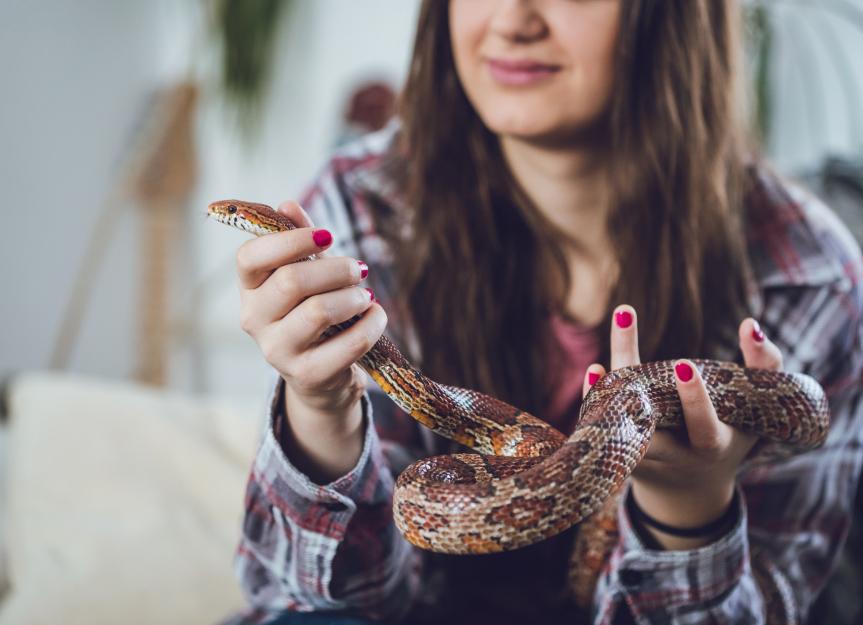
Holding your pet snake is often one of the most rewarding parts of being a snake pet parent—but only if you do it safely. Whether you are new to reptile-keeping or you want to improve your relationship with your scaly pal, taking the time to learn safe snake handling techniques can help you avoid causing stress or injury to your snake.
Let’s explore how to hold your pet snake to build trust, ensure their safety, and avoid getting bitten.
Key Takeaways
- Proper snake handling is important to keep you and your pet safe.
- Pick up your snake in a calm, quiet environment and check their body language to confirm they are relaxed before handling.
- Reach toward your snake from the side and support their body at all times.
- Let your snake move over you instead of restraining them in your arms.
Preparing for Pet Snake Handling
Before you handle your pet snake, take a moment to get ready. A few easy steps will create a good environment for you and your snake to spend quality time together.
Wash Your Hands
Always wash your hands before and after working with your snake. There are a couple of reasons why this is important:
-
Feed response: Snakes are more primitive than our dogs and cats. They rely on smell and sometimes sight. A feed response simply means they think there’s food in front of them. If a snake bites when they mistake you for food, they will not let go. Seek medical attention if you are bitten by any snake.
-
Bacteria: Reptile skin can hold bacteria that make us sick, especially salmonella, even when they are healthy and clean. You can also unwittingly spread something to your pet, and snakes do not often show symptoms of illnesses until they are very sick.
Check Your Environment
Snakes have their best interactions with their people in calm, quiet environments with comfortable (for them) temperatures (generally 70–75 F). If you have other pets, especially cats and dogs, move them to another area.
Observe Your Pet Snake’s Body Language
Body language varies between species. For example, boas tend to keep their necks kinked most of the time, while pythons only do it when they feel defensive. You will need to learn your pet snake’s body language.
Even though there are differences, there are many similarities too. Before you reach in to pick up your snake friend, watch for and consider the following:
-
Relaxed tongue flicks: Just like a dog’s tail, your snake’s tongue will tell you a lot about their state of mind. Tight, fast, and stiff tongue flicks mean they are nervous and likely to strike, while loose, relaxed, slow, even “waggly” tongue flicks are a sign of comfort and curiosity.
-
Relaxed, loose posture: If your snake is comfortable and feels safe, they probably won’t be coiled in a corner. Of course, some species sleep coiled up tightly on branches, so consider the species.
-
Cloudy eyes: Bluish, cloudy eyes tell you that your scaly pal is getting ready to shed. Most snakes get defensive when they are shedding because they temporarily can’t see well, or even see at all. Do not handle your pet at this time unless it’s an emergency.
How To Pick Up a Snake, Step-by-Step
All set to open your snake’s enclosure and hold your scaly pal? Here’s how to pick up a snake without making them feel threatened—or thinking there is a meal in front of them.
-
Approach your snake’s enclosure slowly and calmly. Snakes react to fast, agitated movements, so the calmer you seem, the calmer they will feel.
-
Gently tap the snake in the middle of the body with a snake hook, like this one from Zoo Med, before picking them up.
-
Reach from the side or rear, not the top. Many predators come from above, and if you reach for your snake from above, they may see you as a predator. This is why many experienced keepers recommend front-opening enclosures, like this one from Repti Zoo.
-
Support your snake’s body. Bigger snakes need both hands, and if your snake is bigger than about 8 feet long, have a friend there to help. Lift your pet snake from the mid-body, never the head or tail. Snake bodies are almost all spine and more fragile than you expect.
-
Don’t “hold” your snake. Instead, let them move over you. Many people like using a “hand-over-hand” movement, which allows the snake to move without getting away or being restricted.
-
Do not hesitate or stare your snake down before picking them up. Snakes respond to your body language and behavior too. If you are hesitant or nervous, your snake will also get nervous and defensive, which can lead to a strike.
Returning Your Snake to the Enclosure
When you are ready to put your snake back in their enclosure:
-
Lower them gently into their home.
-
Allow them to slither off your hands before you close their habitat, then wash your hands.
Common Snake Handling Mistakes To Avoid
There’s always a learning curve when handling any new pet. Keep the following in mind when you attempt to handle a snake:
-
Don’t hold your snake too tight. Remember, snakes are mostly spine, and injuries can be very serious.
Tips for Building Trust Over Time
Although they may seem too primitive to form bonds, snakes can learn to trust their people. With time, patience, and gentle handling, they may even seek attention from you.
Here are some tips for building trust with your snake:
-
Use feeding tongs, like this one from Symton, when offering food to your snake. This helps prevent bites and keeps your snake from associating your hands with food.
Snake Handling FAQs
What is the correct way to hold a snake?
Always support a snake from the middle of the body with one hand and use your other hand to support the rest of the body to prevent injuring them. Never hold a snake by the head or the tail.
How long should you wait to handle a snake after feeding?
At least 48 hours—more if their last meal was very large.
What snakes like to be held?
Corn snakes, along with some ball pythons, reticulated pythons, and ground-dwelling boas, seem to seek out their pet parents. But snakes don’t have the same social bonds as mammals, so we can’t expect the same level of sociability.



